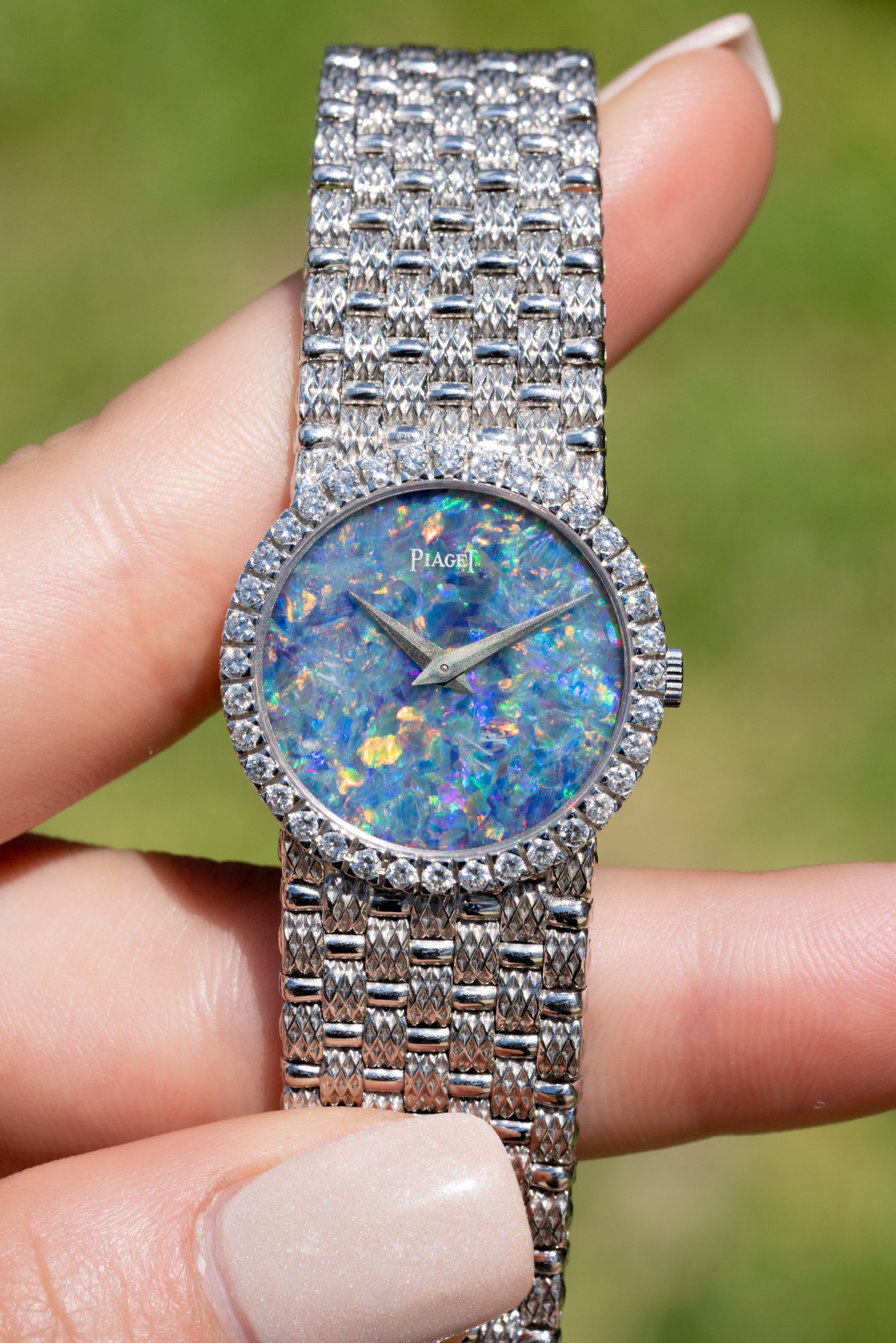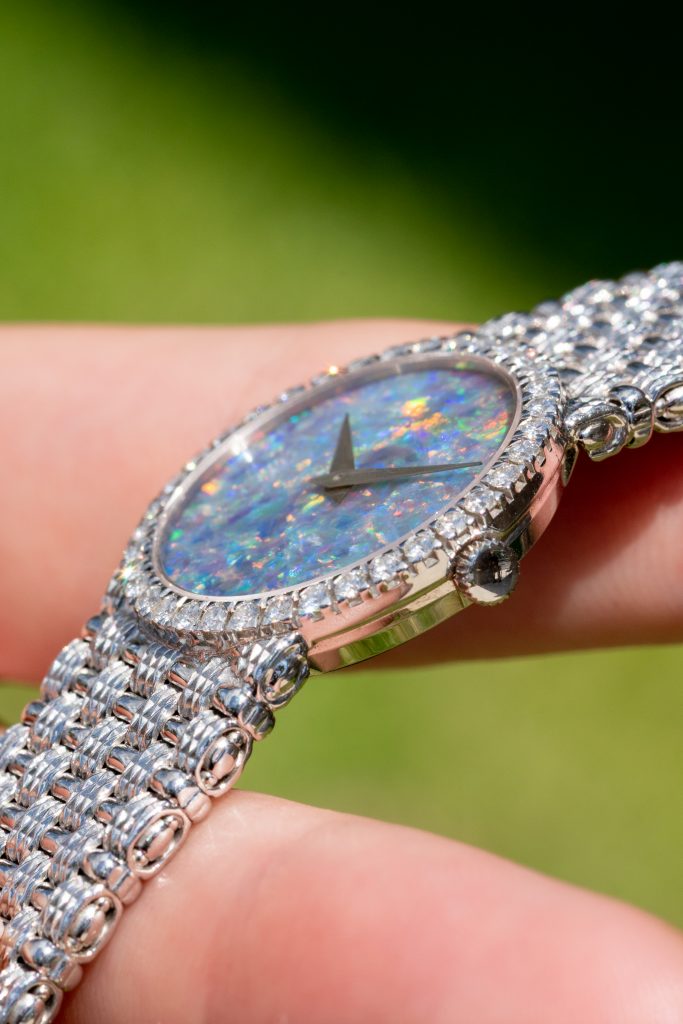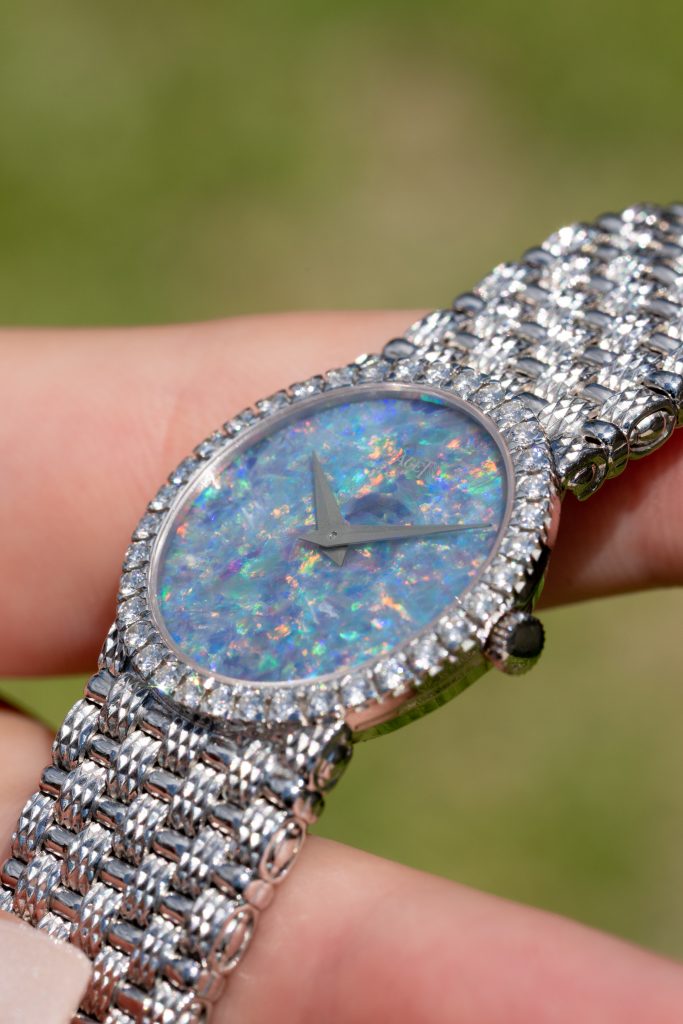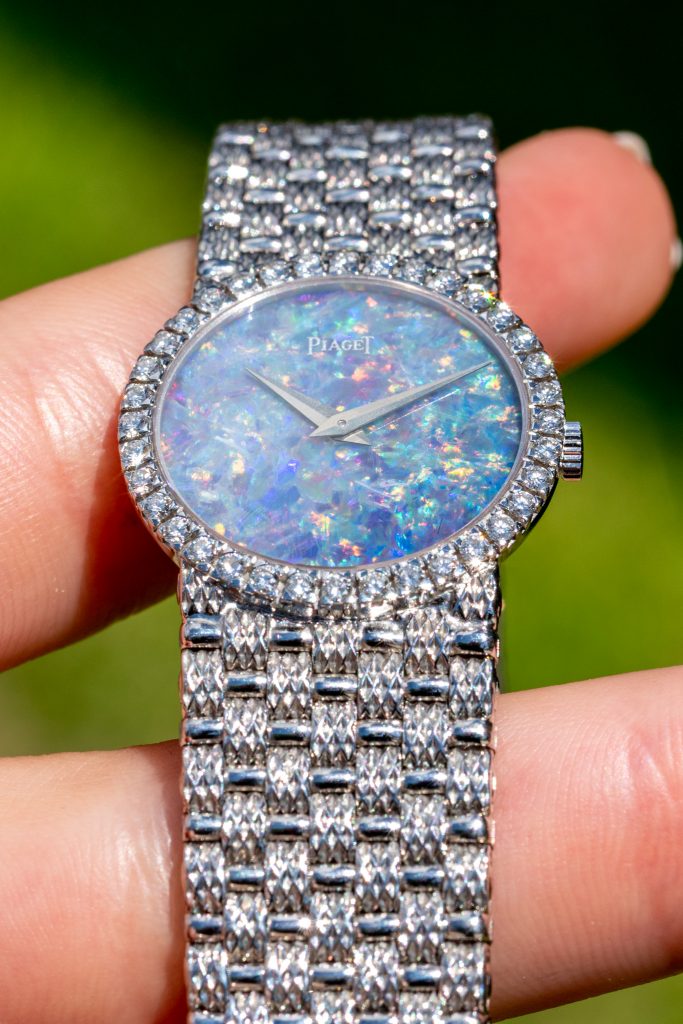OPAL DIAL PIAGET WATCH REVIEW

Wristwatches made in the ‘60s and ‘70s like opal dial Piaget watches were not just accessories. These pieces of jewelry must meet certain levels of functionality as well. Not just that, they must come with a considerable amount of aesthetic qualities to match the functions.
Meanwhile, this main stress placed on functionality is not a mere random occurrence. For functionality to match beauty was and is still a significant yardstick in reviewing any timepiece. This emphasis is a result of the struggle between the mechanical timepiece and their electronic counterparts
The situation was quite similar in the Piaget circle. Watches made in those times had clear signals pointing at their functionality, as well as their beauty. When you see an opal dial Piaget watch, this balance becomes even clearer.
Introducing The Opal Dial Piaget Watch
We begin from 1956 when Piaget introduced an ultra-slim watch. The dial of this watch was large enough for graceful women to read without the help of spectacles.
Thereon, changes came in 1964. Then, the two-millimeter high case witnessed the introduction of hard-stone dials. They were only seven-tenths of a millimeter thick. These dials came in different shades. They include:
- Jade
- Lapis-lazuli
- Malachite
- Quartz
- Tiger’s eye
- Opal
- Turquoise
- Onyx
- Coral
- Mother of pearl, etc.
There were as many as 30. All revolving around a single theme. Consequently, Piaget could cement an enduring significance in the world of precious watches. This is all thanks to the dials variations.
Additionally, these watches again came in large sizes. This sizing was a deviation from the norm in this aspect of watchmaking. More so, it made figures and hour pointers needless.
These new watches from Piaget had more of a jewelry impression than a typical wristwatch. They featured the true aura of jewelry all around them. These bejeweled timepieces were similar to the diamond-paved types made later in the 20th century.
As expected, these dials like the opal dial were imposing. And, for the fact that they took up space, they needed a wide bracelet to go along with. Thereafter, this wide bracelet became the blank canvas upon which this show of artistry occurred. As well as, the stimulus needed for infinite trials.
Introducing Hard Stones To Dials
At the turn of a new decade (the 1970s), Piaget introduced the use of hard stones. These hard stones will feature both in dials and for decorating its large wrist watches for men and women.
Truly, the style was distinctive, yet these watches did not lack any bit of creativity. It was in this era that the brand reintroduced an age-long trend. The trend of sporting a watch featuring a precious chain wrapped around its neck.
This trend was a perfect fit with the styles of the era. Primarily, this era emphasized social mobility. It prompted a serious shift in tastes.
At that point, this jewelry watch already had enough bold qualities. However, it still embraced the rainbow shades of sapphires, emeralds, diamonds, and rubies. Before long, others followed suit. And, this same white, red, blue, and green became the norms a few years later on most timepieces.
Furthermore, in 1976, we witnessed the creation of a timepiece with a different kind of dial. Here, the diamonds stayed in between two sapphire crystals and hover freely through the dial. That was the introduction of the Opal dial Piaget watch for men and women.
However, a new event happened first in 1979. Then, it resurfaced again in 1981. This event welcomed two unique innovations. These innovations soon attained a level of significance. At the time, they were the most expensive jewelry wristwatches. They were new versions of watches with distinct dials.
The Design Of The Piaget Opal Dial Watches
In the period leading to this production, movements for women’s timepieces were quite small. Again, the internally minuscule dials were not in vogue. They were not regarded as a decorative part of these watches.
However, with the coming of the 9P movement, Piaget found the secret weapon they needed. With this secret weapon, they could produce ultra-thin dress timepieces for men. Not just that, Piaget was likewise able to create a new beauty piece for women.
 First off, the caliber was slim enough. That allowed more freedom in the design of watches. Additionally, it was larger in diameter.
First off, the caliber was slim enough. That allowed more freedom in the design of watches. Additionally, it was larger in diameter.
With that, came a bigger dial that provided a new room for decoration. In the process, only an expert atelier cut the dial to a thickness measurement below 1mm. Valentin and Gérald looked into the aesthetic aspect in a new dimension. The entire design began with the dial. Afterward, the bezel comes in before the bracelet of the wristwatch.
Presently, you cannot find too many watchmakers with the readiness to commit themselves to this daunting process. Producing wristwatches with opal stone dials requires effort, skill, and money. All of these are vital components of the production process of opal dial watches.
Let’s take a quick trip back to the 1960s, back then this process was still at the testing stage. Dials could not make it through the machining process. Some others get broken during the hands-setting process.
Despite these difficulties, Gérald and Valentin remained resolute. Thanks to their resolution, Piaget attained the coveted position of being a pioneer in the area. And with the opal dials it introduced, the Piaget brand remained on a different level.
Therefore, it’s not surprising that when the brand chose to introduce fully-crafted wristwatches, the goal was still to be different. Moreover, thanks to the timepieces produced in the post-war decades, opal dial watches established themselves in no time.
The Process Of Making Piaget Opal Dial Watches
All stoned dial watches come in a unique variety. Through these dials, the wristwatches take a new form of artistic elegance. Various procedures like sculpture, enameling, engraving, and painting work to improve the glamour of these watches.
Similarly, Piaget utilizes precious stones to make the dials featured in their timepieces. With each watch embellished by such jewels, they all come with a distinct aura and appearance.
Selecting The Precious Minerals (Opal)
The first part of the process is the selection of the unique precious minerals. In this case, the needed mineral is opal.
In a bid to effectively execute this art of infusing gemstones into dials, Piaget collaborates with a team of expert artisans. These artisans specialize in semi-precious stones.
More so, these stones selected come from the four corners of the world. Some came from Europe, some from Asia, and others from the Americas. All of these stones selected come to Switzerland for the actual tricky cutting procedure.
Polishing The Precious Minerals (Opal)
Once the stones come in, next is the polishing stage. The careful polishing is by hand. After which the stones get chopped into disks slices. These sizes are almost the same size as the final piece.
This cutting process employs the use of regular grinders and saws. It can take as long as one hour to get a prior dial shape.
After this, each dial goes through another round of polishing. This time drilling comes in to produce small rooms for the appliqués, apertures, and hands.
Note: The importance of this step is as the force of the hole-making instruments can still cause a crack on the mineral. This varies in impact hinging on the hardness of the mineral.
More so, utmost care must go into the last phase of the hand-polishing process. The process involves the artisan slowly paring down every dial till it gets to a thickness density of 0.8 mm. Besides, some opal stones get transparent when they get this tiny.
Deburring The Edges
Furthermore, a replica burr comes in to deburr all through the edges. Thereafter, it works on the outer rim to make it smooth.
This process is similarly tricky as the tiniest fractions of the stone can still crack. At this point, what you see is nearly an exact circle, completely handmade.
Final Polishing
Finally, the mineral dial goes through another polishing. This will be the final polish. After this, comes the decorations. You might have circular hands, gold hands, appliqués, round bands, or other mobile portions for automation.
Conclusively, this lengthy procedure allows the artisan to use his instruments only. These instruments are often “self-made”. Plus, these instruments can transmit the smallest vibration from a stone straight to the hand of the artisan. The brightness, glamour, and sublime reflections are products of these instruments.
The Movement Of The Opal Dial Piaget Watch
For Piaget as a watchmaking brand, the emphasis was on aesthetics. Moreover, the brand parades an established prestige as top-notch movement creators.
At the time, the primary goal of the brand was to create an ultra-thin caliber. That way, they can keep their cased timepieces as thin as possible. Consequently, in 1957, there was the launch of the hand-wound Caliber 9P.
In detail, the caliber was only 2mm high. Therefore, it enabled the seamless design and production of some of the most daring wristwatches made in the mid-20th century.
Besides, another caliber came afterward to partner with this revolutionary production. This is the automatic-winding 12P caliber. They both served as the motivation for all the Piaget ultra-thin movements produced afterward.
The Impact Of The 9P Caliber
The 9P was a product of determination and conviction placing the aesthetic on the same level as the functionality.
The Piaget brand fixed its focus on understanding and dealing in ultra-thin timepieces. Likewise, the brand targeted the dress end of the watch community. They would rather be a powerhouse there instead of in sports or utility watchmaking.
Subsequently, Piaget continued step-by-step to produce designs and innovations that are audacious. Not just limited to creating lovely sketches or intuitions. Piaget proceeded to perfect the execution of these timepieces.
The success of the brand in producing a piece that stands out in the watch market is not far-fetched. There were creations like the 9P caliber. Also, the resolution to understand the very complicated job of cutting and working with hard stone played parts in this success.
Uniqueness Of Opal Dial Piaget Watches
The pictures above say a lot about this piece. Clearly, it is nothing less than spell bounding. The elegant opal dial coupled with the other parts of the watch reveals nothing but elegance and artistic excellence. A dial made from a good amount of fire opal works perfectly as the pictures show.
Over time, it is clear that stone dials are now a label ascribed to the Piaget brand. This began from the moment this opal dial debuted in 1964.
Since then, opal dial Piaget watches continue to stand out thanks to this unusual stone used in its dials. The other parts of opal dial watches show an equal amount of glamour and aesthetic brilliance. The bracelets, the bezel, the case, the clasp, and the movement are all testaments to this fact. They all come together to reveal a unique timepiece with grandness in beauty and functions.
As you can see, this timeless is not for everyone. Some people might love its appearance while others would not. Opal dial watches are the main statement creations. To get the best from it, you have to be the best person for it.
Conclusion
Even with the complicated peculiarity and cost of this wristwatch, it is still one to adore. You can’t help but feel the loveliness and grandness that comes with its amazing retro style.
Also, this is an industry where the majority of women’s wristwatches come with too many adornments. This applies to the smaller models of men’s watches as well. Yet, this wristwatch still manages to pass on that special aura. Although you cannot take away the lustrous history it boasts of from its grandness.
Aside from the historical relevance of this wristwatch, other factors contribute to its success over time. It is not due to its price or the way it excessively uses diamonds. The design of the opal dial Piaget watches plays a major role in the success of these timepieces.


